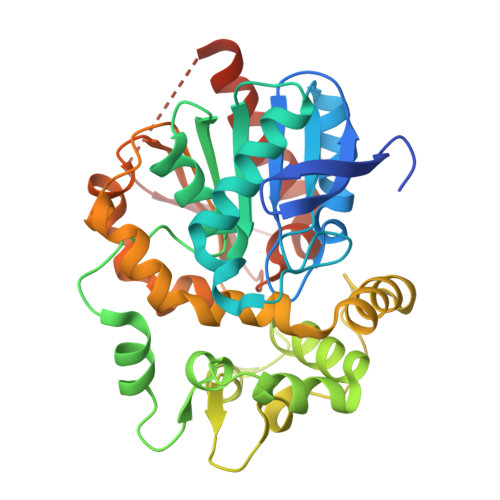An epoxide hydrolase from endophytic Streptomyces shows unique structural features and wide biocatalytic activity.
Tormet-Gonzalez, G.D., Wilson, C., de Oliveira, G.S., Dos Santos, J.C., de Oliveira, L.G., Dias, M.V.B.(2020) Acta Crystallogr D Struct Biol 76: 868-875
- PubMed: 32876062
- DOI: https://doi.org/10.1107/S2059798320010402
- Primary Citation of Related Structures:
6UNW - PubMed Abstract:
The genus Streptomyces is characterized by the production of a wide variety of secondary metabolites with remarkable biological activities and broad antibiotic capabilities. The presence of an unprecedented number of genes encoding hydrolytic enzymes with industrial appeal such as epoxide hydrolases (EHs) reveals its resourceful microscopic machinery. The whole-genome sequence of Streptomyces sp. CBMAI 2042, an endophytic actinobacterium isolated from Citrus sinensis branches, was explored by genome mining, and a putative α/β-epoxide hydrolase named B1EPH2 and encoded by 344 amino acids was selected for functional and structural studies. The crystal structure of B1EPH2 was obtained at a resolution of 2.2 Å and it was found to have a similar fold to other EHs, despite its hexameric quaternary structure, which contrasts with previously solved dimeric and monomeric EH structures. While B1EPH2 has a high sequence similarity to EHB from Mycobacterium tuberculosis, its cavity is similar to that of human EH. A group of 12 aromatic and aliphatic racemic epoxides were assayed to determine the activity of B1EPH2; remarkably, this enzyme was able to hydrolyse all the epoxides to the respective 1,2-diols, indicating a wide-range substrate scope acceptance. Moreover, the (R)- and (S)-enantiomers of styrene oxide, epichlorohydrin and 1,2-epoxybutane were used to monitor enantiopreference. Taken together, the functional and structural analyses indicate that this enzyme is an attractive biocatalyst for future biotechnological applications.
- Department of Organic Chemistry, Institute of Chemistry, University of Campinas, Campinas-SP 3083-970, Brazil.
Organizational Affiliation:

















